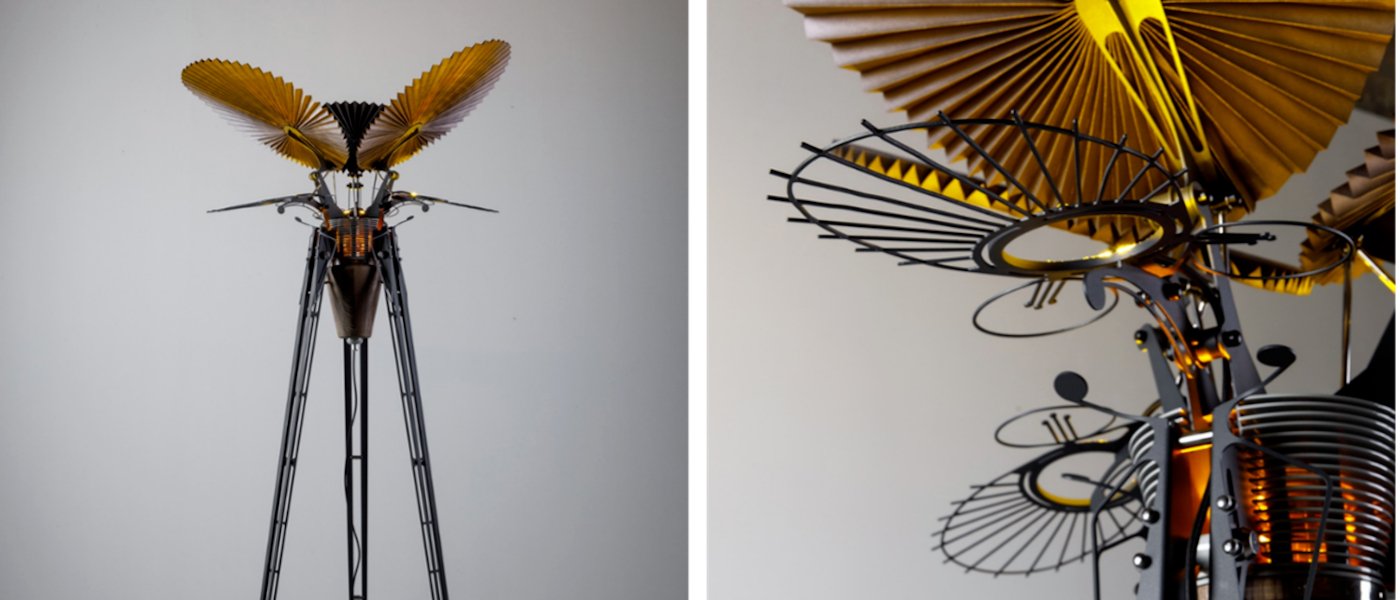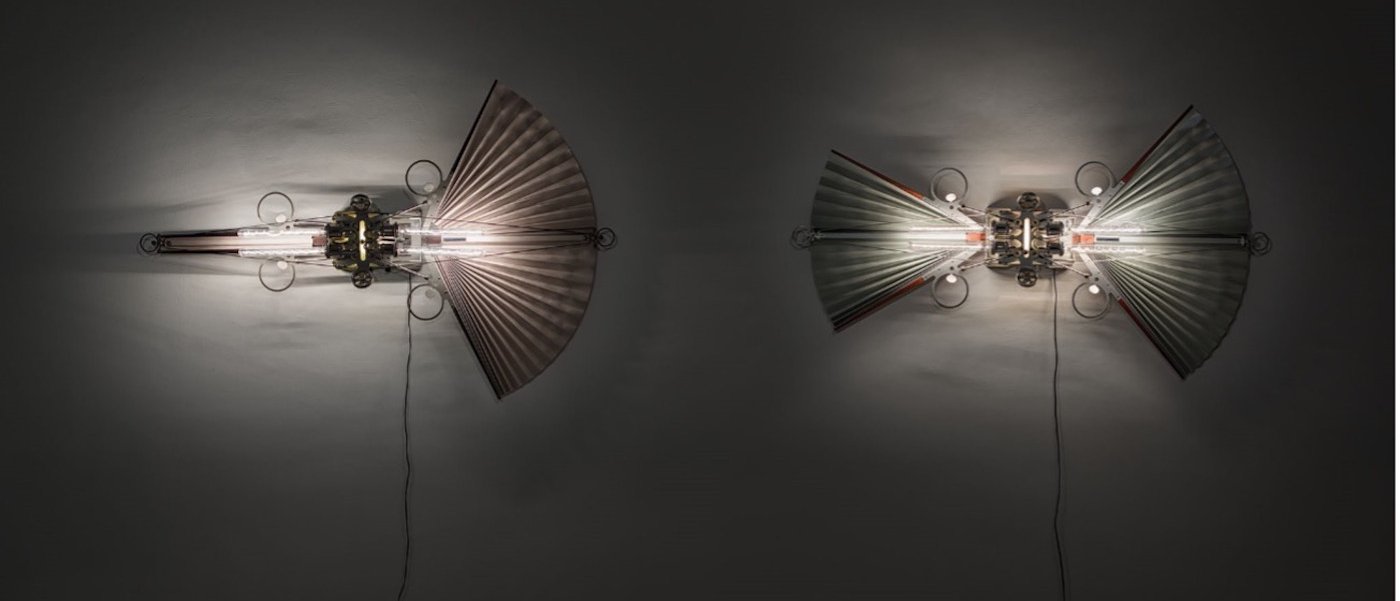aving founded their studio in 2020, artists Smith & Winken, whose real names are Valeriy Kuznetsov and Otto Winken, developed a signature style involving mechanics and architectural proportions to highlight the beauty of our everyday world from a new perspective. Their artwork is technical and unexpected. Using mundane materials, they creatively demonstrate connections between mechanics and bionics. These artworks remind us that each being is a mechanism in a way.
The duo has brought forth a series of kinetic objects grouped in a collection called Endless Movement that can almost be characterized performance art. Endless Movement is a collection of limited-edition kinetic sculptures currently containing 18 artworks. The MB&F M.A.D.Gallery in Geneva has the pleasure of featuring five of these: Thrinax, Apollo 18, Hover, and two variations of Skipper.
Endless Movement provides a feeling of the fourth dimension, where the nature of mechanics shifts ever so slightly. The collection uses wood, textiles, and metal as the primary materials, while the elements of the sculptures are set in motion by specially designed mechanisms powered by electricity. The ratios of proportions and materials, details, and range of motion of each element are carefully crafted to jibe with those of human beings in order to provoke a desire in the observer to communicate with the art. The motion of each artwork is so conscious and quiet that the mechanisms appear as living organisms that might have existed in the distant past or the unpredictable future on any planet in the universe.

Thrinax, made of metal and North American walnut, looks like it’s ready to take off. And, indeed, it can flap and light up on demand. Despite the heavy, tropical-looking wood used in its making, the open plan of its design makes it seem so light that it could float. Vaguely inspired by the image of a palm tree, the hypnotic motion is comforting and mesmerizing at the same time. Thrinax measures 1160 mm (width) x 1860/2100 mm (height) x 1160 mm (diameter) and is limited to 20 pieces.
Pulsating from side to side, light sources going along for the ride, Skipper symbolizes life cycles. Made of contrasting metal and textile pleats, Skipper reminds us of both the durability and fragility of life. The artists decline to reveal the obscure inspiration for this piece, insisting that, “The observer sees what they want to see.” Available in chrome or graphite at the MB&F M.A.D.Gallery, Skipper is limited to 10 examples in each variation and measures 1540 mm (width) x 1030 mm (height) x 185 mm (diameter).
Apollo 18, on the other hand, was inspired by the real-life fact that NASA’s Apollo missions finished with Apollo 17. This sculpture thus poses the question what Apollo 18 might have been. “Is it finished?” asks Smith (Kuznetsov). Made of stainless steel, ash wood, and other metal, this object comprising 484 individual components pulsates in tune with the infinity of the universe. Apollo 18 measures 1120 mm (width) x 1610 mm (height) x 800 mm (diameter) and is limited to 12 examples.
Is it an insect or is it Hover? This sculpture with its wild “eyes” lurks and pulses as if it came straight out of the woods. Ambiguously inspired by a butterfly, once activated it seems to float thanks to “wings” made of textile pleats, which come in grey or blue. Limited to 10 examples, Hover measures 240/920 mm (width) x 940 mm (height) x 95 mm (diameter).
Smith & Winken undertook a mechanical renaissance of sorts to put the beauty of mechanics in the electronic-virtual era on display. The main task of each artwork is to display organic harmony in the mechanics while ensuring that the object is artistic and meaningful based on the duo’s perception of life and origin.
Kuznetsov and Winken usually find the inspiration for a piece from an art image – “in a dream,” the duo laughed when asked – after which they make sketches and determine the piece’s size, proportions, and dimensions. The duo does not use software for their sketches; no CAD or CAM is used in the making of these artworks at all. Instead, they manually draw their own blueprints.
They make their first prototypes in wood and paper, after which they make the components, some of which are made by hand and some with the help of machinery. Every single part used in the duo’s art is custom made for that artwork. Finding the precise measurements for those components is not an easy process and can take months. “We have an entire museum full of rejects,” Winken quipped with regard to the scrap metal pile that represents the process. “The work must be precise to get it right, much like the components of clock mechanisms.” All the metal parts, whether handmade or from a machine, are beautifully finished by hand, also much like watch movement parts.

The primary materials used in the duo’s art are natural – wood, textile, and metal – for a timeless representation. The carefully constructed details make each sculpture a holistic mechanism that seems to be alive. “Each of the collection’s objects arose as an attempt to learn from the basic mechanisms and patterns of interaction between earth structures, living and artificial,” Smith explains the objective of his art. “Again and again, we raise the question ‘What is life?’ Exploring scenarios of the future, we demonstrate the hypothetical forms that can develop in the process of evolution.”
“There are no technical or technological revolutions in the Endless Movement project. Our goal is to observe, study, and rethink the world around us [in] an attempt to slow down and realize that everyday materials and phenomena can look totally different,” adds Winken.
“These objects are like finely crafted watches, which in the electronic age are more of a luxury item than a functional necessity,” Kuznetsov philosophizes. “Today mechanical watches are used to admire the movement of perfect mechanisms, to observe the passage of time and the ideal accuracy of its measurement. Endless Movement is also about a kind of time count, which is produced by the uniform motion of the sculptures’ moving elements.”
Smith (Valeriy Kuznetsov) is the co-founder of Ukrainian design studio decorkuznetsov. He has authored or co-authored more than 250 interior and architectural projects and participates as a juror or expert in many European exhibitions. Above and beyond that, he has won international awards, including Red Dots for design concepts in 2020 and 2015.
Otto Winken is a Ukrainian engineer and architect of Austrian ethnicity who has numerous architectural and unique design projects under his belt.
The Smith & Winken studio is located in Dnipro, Ukraine, the centre of the space industry in the USSR era. Images of early space exploration are as inspirational to the duo (with Kuznetsov stating that it excited “a tapestry of imagination”) as the colours used in the paintings of Dutch masters like Bosch, Brueghel, and Rembrandt.
A current trend that motivates the duo is the “fusion” of technology, design, and art. Endless Movement, decidedly more about art than architecture despite the two artists’ roots, is but a stepping stone to a future dream involving a performance with their sculptures.
To see these mechanical marvels, you can either book a private appointment to visit our gallery in Geneva or visit the M.A.D.Gallery online to dive into the dynamic world of kinetic art.







